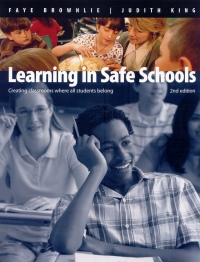| ________________
CM . . . . Volume XIX Number 3 . . . . September 21, 2012
excerpt:
Learning in Safe Schools was first published in 2000. In this second edition, Faye Brownlie has teamed with Judith King and numerous classroom teachers to create a book rich in thoughtful ideas that can lead novice and experienced teachers to reflect on and embrace practices that build inclusive schools and classrooms for the increasingly diverse body of students we see enter our school doors. Administrators can glean new ideas for building supportive teams and adapting schedules to meet the needs of more students and their teachers. This teacher resource book, written to all K to 12 classroom and resource teachers, as well as administrators, opens with an introduction that defines and illustrates the concept of inclusion to better meet the needs of all students within the classroom setting. After a discussion of the core values and beliefs of their model, the authors quickly move into how to begin and continue this "journey." Their approach is one of collaboration with parents, all staff, any other support personnel and the students. The 11 chapters of this book are divided into three distinct parts: Building an Inclusive School; Teaching so all Students Can Learn; and Taking "Ownership" of All Students. The focus of Part One is on building an inclusive school by developing a school-wide code of conduct, building a culture where all students belong, and introducing a number of ways to explore the concept of learning as a journey. The chapters contain concrete examples of student work and describe practical steps to follow. Part Two speaks to teacher planning, recommending and outlining a model that starts planning with the end in mind; therefore, teacher planning moves from identifying outcomes to deciding how students will demonstrate their learning, and how they will be assessed. Planning stages include suggestions on how to connect to prior knowledge, get students to process new information, to personalize their learning and to plan for adaptations of an inclusive nature. A detailed sample lesson sequence and a checklist for creating an inclusive classroom are included. Three classroom stories that build engagement, community, and academic confidence round out the following chapter. Chapters 6 and 7 discuss creative ways of building an inclusive culture in secondary and intermediate classrooms. Part Two concludes with a chapter that discusses practical ways to make adaptations and modifications to improve learning. The six adaptations addressed are: goals/expectations, environment, teacher presentation, materials, assistance, and evaluation. These suggestions for adaptation are followed by specific classroom examples that have been successful: grade 6 math, grade 3/4 spelling, grade 8 readers' workshop and a grade 5 class novel read-aloud. The details provided assist the reader in visualizing and gaining a deep understanding of these adaptations. The summary pages of adaptations and the program analysis worksheets would also assist any teacher in making changes to their practice. Part Three discusses how to develop a resource model for your school that is primarily within the regular classroom. Various examples of how this might work are discussed at both the elementary and secondary level. Sample timetables are also provided. A step-by-step process for conducting/implementing class reviews is recommended and outlined. A Class Review is a formative assessment of the strengths, needs and goals of all the students in a classroom. It is completed by the classroom teacher and then discussed with a support team. Completed and blank forms are included, and examples of various class reviews are clearly depicted. The final chapter discusses a Multi Action Planning System (MAPS) as a model for planning for individual students. The step-by-step process and scripted example will assist educators who see the benefits of adopting this model. A missing concluding chapter could draw these approaches together to provide a starting point for an educator wishing to make changes; in lieu of this, the introduction could be re-read and ideas shared with potential supportive colleagues. Appendices include two critical thinking strategies to engage students and two forms for curriculum adaptations. The Annotated Bibliography of Classroom Resources provides a synopsis and key themes of recommended picture books, primary and intermediate/middle books appropriate for K – Grade 7 students. The index is detailed, and the Professional Bibliography provides many resources to delve deeper into the ideas presented. Reading this book could lead to reflection and a close examination of your current practices. The implementation of these approaches to teaching and learning in our schools would lead to more inclusive and safer schools for all students and teachers. The rich teaching and consulting experiences and commitment of Brownlie and King are evident throughout this timely and pragmatic resource. Highly Recommended. Betty Klassen teaches in the Middle Years Program in the Faculty of Education at the University of Manitoba in Winnipeg, MB.
To comment
on this title or this review, send mail to cm@umanitoba.ca.
Copyright © the Manitoba Library Association. Reproduction for personal
use is permitted only if this copyright notice is maintained. Any
other reproduction is prohibited without permission.
NEXT REVIEW |
TABLE OF CONTENTS FOR THIS ISSUE
- September 21, 2012.
AUTHORS |
TITLES |
MEDIA REVIEWS |
PROFILES |
BACK ISSUES |
SEARCH |
CMARCHIVE |
HOME |
